Altcoin Season Delayed? 2025 Crypto Market Cap Trends Explained
%201.svg)
%201.svg)

In 2025, much of the altcoin market remains subdued. Prices for many tokens are still down more than 90% from their all-time highs. Despite sporadic rallies and renewed interest in certain sectors like meme coins or AI, a broader altcoin season has yet to materialize. The question facing many crypto investors now is: why?
In this analysis, we explore the macro and structural reasons for altcoin underperformance, unpack the liquidity bottleneck, and discuss what might change this narrative going forward.
The Data: Altcoins Still Deep in the Red
By mid-2025, most altcoins remain far below their PEAQ valuations from the last cycle. While Bitcoin and a few select large caps have recovered or even set new highs, the broader altcoin ecosystem continues to lag. This decoupling is not new—it happens every cycle—but the magnitude and persistence this time are notable.
A combination of market structure changes and supply-side dynamics are likely responsible.
Why Liquidity Hasn’t Returned
The most critical variable is liquidity. In previous bull runs, altcoin rallies were fueled by large inflows of new capital. This fresh money—often speculative—moved quickly through different sectors, inflating valuations across the board.
Today, however, the crypto market cap sits at around $3.3 trillion, with only ~$300 billion in net new capital added since the start of the cycle. At the same time, there are far more tokens than ever before. This mismatch between capital and available supply has diluted flows and suppressed upside for all but the strongest assets.
Instead of every token catching a bid, capital is rotating selectively, often into Bitcoin, a few meme coins, or tokens associated with highly visible narratives.
Token Supply Has Exploded
One major shift is the sheer number of tokens now on the market. Since the last bull run, the number of tradable crypto assets has increased significantly—perhaps by an order of magnitude. Many of these tokens have little to no trading volume, real users, or sustained community.
This oversupply of assets creates a fragmented market where attention and liquidity are spread thin. As a result, the days of altcoin beta—when nearly every token would rally simply because “the market is up”—may be over.
Going forward, performance may rely more on fundamentals, usage, and real demand.
Sector Rotation Dominates
Rather than broad-based rallies, the market is experiencing sectoral rotations. Capital flows aggressively between narratives: from meme coins to AI tokens, then to DePIN, and perhaps next to RWAs or perpetual DEXs.
This “hot potato” behavior means even when a sector performs, it's often short-lived. Many traders chase the next hype wave rather than allocating with conviction. The result is volatility without trend sustainability, and thin liquidity across most altcoins.
Institutions Are Still Focused on Bitcoin
Another reason altcoins lag is that institutional interest remains centered on Bitcoin—and to a lesser extent, Ethereum. This is particularly true in 2025, as the regulatory landscape slowly becomes more defined and risk appetite stays muted.
Bitcoin continues to benefit from a macro narrative that positions it as a hedge against inflation, fiat instability, and geopolitical risk. With potential for further escalation in global conflicts and economic uncertainty, BTC is often the first and only crypto asset to attract serious inflows.
Until altcoins can offer a comparable use case or risk-adjusted return, institutional capital will likely remain concentrated in BTC.
What Needs to Change
There are several potential catalysts that could eventually bring altcoins back into focus. These include:
- Improved Liquidity: More capital entering crypto markets through new ETFs, stablecoin infrastructure, or sovereign adoption.
- Macro Stabilization: A return to risk-on environments globally could expand investor appetite for high-beta crypto assets.
- Real Usage: Tokens that can demonstrate strong on-chain revenue, user growth, or ecosystem traction may attract sustained demand.
- Narrative Shifts: New technological breakthroughs or mass adoption events (e.g., consumer applications, financial integrations) could lead to renewed enthusiasm.
- Token Burn and Scarcity: Projects that reduce supply through burns or buybacks may outperform in a low-liquidity world.
Avoiding the “Musical Chairs” Risk
An important takeaway from the current market environment is the growing risk of holding underperforming assets too long. The metaphor of “musical chairs” applies here—when the music stops, not all tokens will have a place.
Just as the dot-com bubble led to a major culling of internet companies, the crypto market may be undergoing a similar filtering process. Those with product-market fit, sustainable economics, and user adoption will likely survive. Others may not recover.
Bitcoin as the Benchmark
Bitcoin has become the benchmark asset for crypto, both in terms of performance and narrative. It remains the asset most closely tied to global macro conditions and institutional flows.
Its relative strength has made it a measuring stick for evaluating the rest of the market. Many altcoins are now being judged not just in fiat terms, but in BTC-relative performance. If they can’t outperform Bitcoin on a risk-adjusted basis, they may struggle to justify their place in portfolios.
Long-Term Outlook: Selective Optimism
Despite short-term underperformance, we remain open to altcoin opportunities—but with greater caution and selectivity. The current environment favors a “barbell strategy”: holding a core position in Bitcoin while selectively allocating to altcoins with verifiable traction.
This is no longer a market where every token rides the same wave. Success in 2025 likely comes from identifying the few that can break out due to clear product value, strong teams, and real-world adoption.
Conclusion
The altcoin market in 2025 reflects a maturing, more fragmented crypto ecosystem. The free liquidity and speculative exuberance of previous cycles have given way to a more competitive, filtered environment.
For investors and builders alike, this isn’t a reason to despair—but a reason to be more focused. As the market resets, those who adapt their frameworks to the new reality may find long-term success. The next wave of winners may already be building—quietly, under the surface.
AI Agents in Minutes, Not Months


Create Your Free Token Metrics Account





.png)
Recent Posts
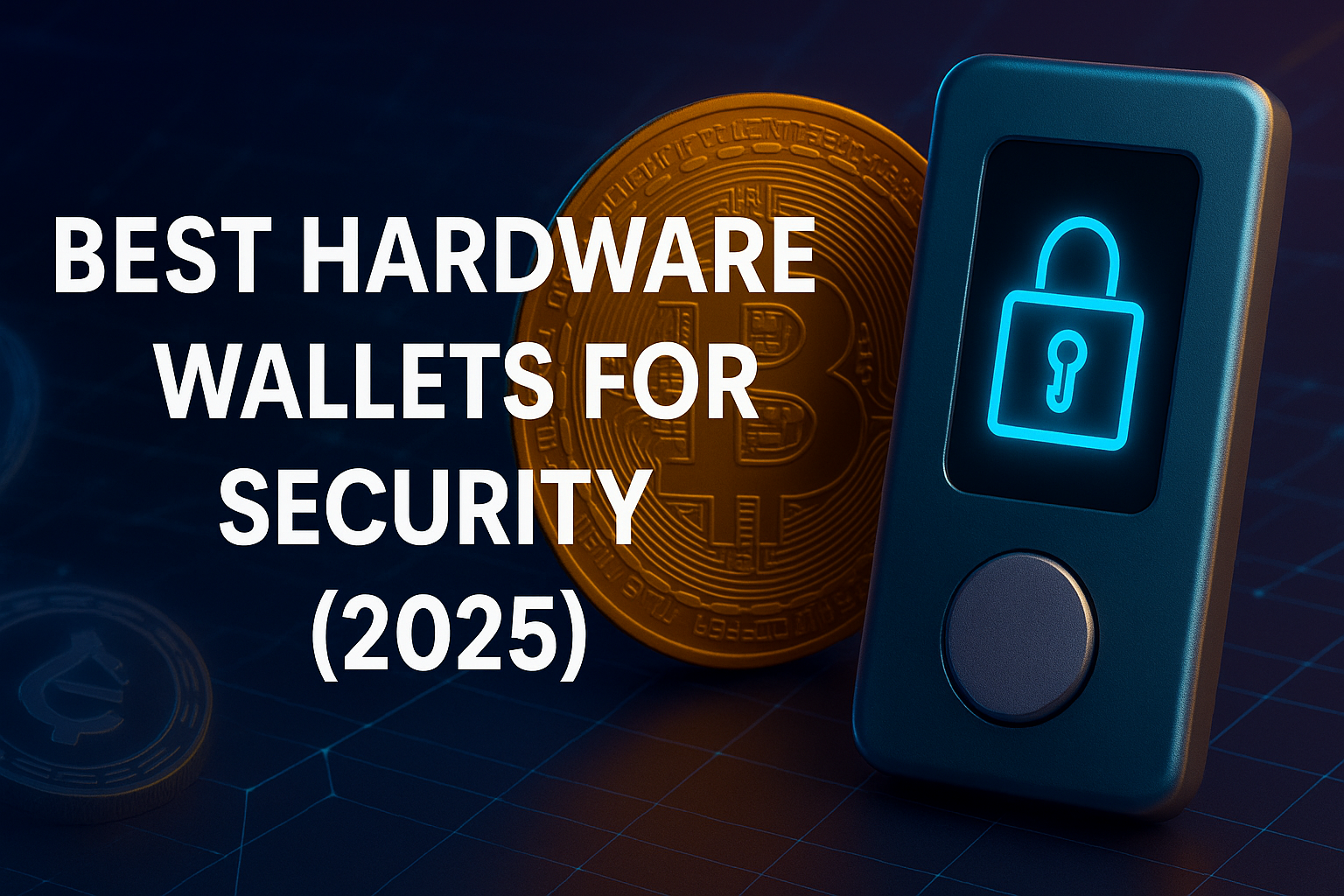
Best Hardware Wallets for Security (2025)
%201.svg)
%201.svg)
Why Hardware Wallets Matter in September 2025
If you hold crypto, your keys are everything—and the best hardware wallets still offer the strongest defense against malware, phishing, and exchange failures. A hardware wallet is a dedicated, offline signing device that stores private keys and authorizes transactions without exposing secrets to the internet. In 2025, rising on-chain activity and more sophisticated wallet-drainer attacks make physical key management table stakes for both retail and pros.
This guide is for investors, traders, and builders who want maximum security without killing usability. We compare leading devices across security architecture, open-source posture, coin coverage, UX, and ecosystem readiness—so you can match the right wallet to your risk profile and stack. Secondary considerations include “crypto hardware wallet” setup flows, “cold wallet” signing paths, and “secure crypto wallet” recovery options.
How We Picked (Methodology & Scoring)
- Liquidity (30%) → Practical access to ecosystems: native apps, partner integrations, staking/buy features, and compatibility with third-party wallets.
- Security (25%) → Secure elements, open-source/ reproducible builds, air-gapped flows (QR/PSBT), anti-exfiltration, audits, and recovery design.
- Coverage (15%) → Supported chains and tokens (BTC, ETH/L2s, EVM, Solana, etc.).
- Costs (15%) → Device price and any ongoing subscription/feature fees.
- UX (10%) → Screen size, inputs, mobile/Bluetooth, onboarding, backups.
- Support (5%) → Docs, firmware cadence, and customer support options.
We relied on official product and security pages, device docs, and transparency notes, using third-party market datasets only for cross-checks (no third-party links in body). Last updated September 2025.
Top 10 Hardware Wallets for Security in September 2025
1. Ledger (Nano X • Nano S Plus • Stax) — Best for broad ecosystem + Secure Element
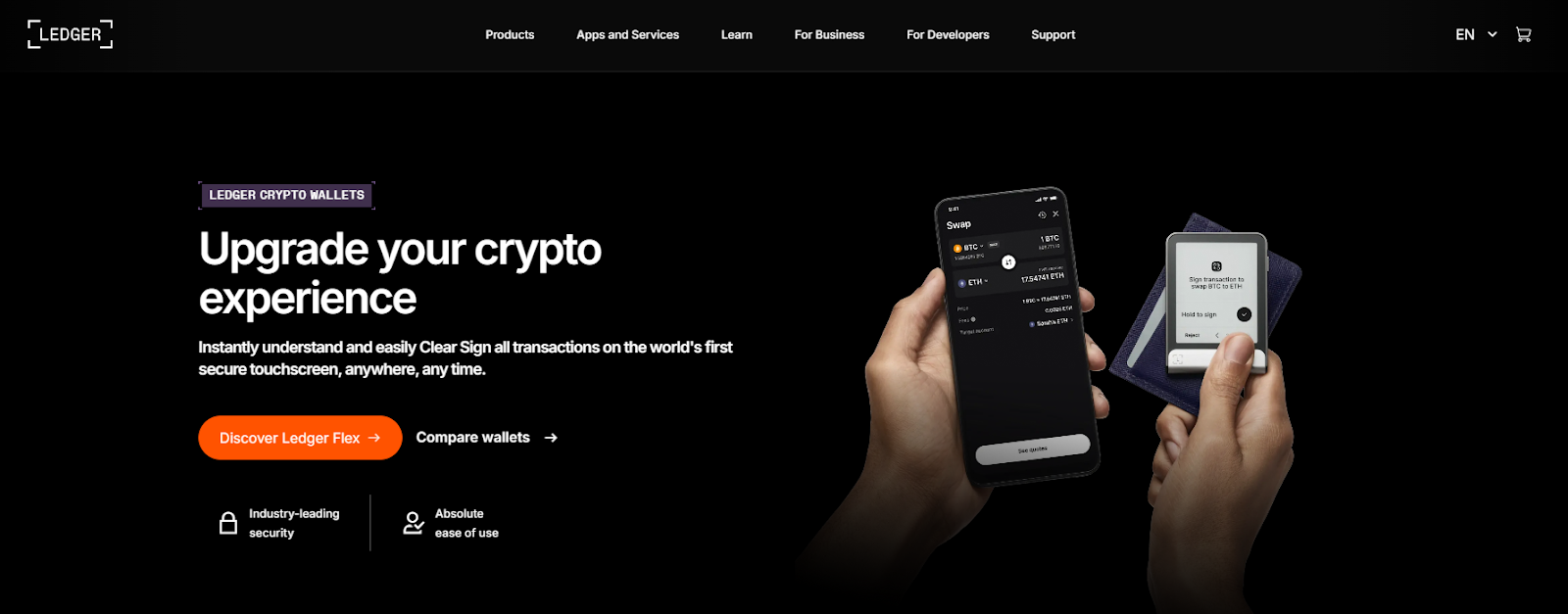
- Why Use It: Ledger pairs a Secure Element (CC EAL5+/EAL6+) with its BOLOS OS and a polished Ledger Live app for buy/swap/stake and 3rd-party wallet support. It’s the most ubiquitous stack, which means better app integrations and an easy path from cold storage to dApps when you need it. Ledger+2Ledger+2
- Best For: Multi-chain users, DeFi dabblers, mobile-first holders, NFT collectors.
- Notable Features: Secure Element, Ledger Live ecosystem, Bluetooth (Nano X), Stax E Ink touchscreen, optional Recover, 50+ wallet integrations. Ledger+1
- Consider If: You prefer fully open-source firmware elsewhere.
- Alternatives: Trezor, BitBox02
- Regions: Global
- Fees Notes: One-time device purchase; optional services may have fees.
2. Trezor (Model T • Safe 3) — Best open-source experience

- Why Use It: Trezor prioritizes open-source firmware, transparent security docs, and a clean desktop suite. The Safe 3 adds a Secure Element while keeping passphrase and on-device confirmations simple enough for new users. Trezor+1
- Best For: Open-source purists, long-term BTC/ETH holders, privacy-minded users.
- Notable Features: Trezor Suite, passphrase, open-source firmware, Secure Element (Safe 3), Bitcoin-only variant available. Trezor
- Consider If: You need Bluetooth/mobile-first; consider Ledger or Jade.
- Alternatives: Ledger, BitBox02
- Regions: Global
- Fees Notes: One-time device purchase; no subscription.
3. BitBox02 (Shift Crypto) — Best for microSD backups + minimalism
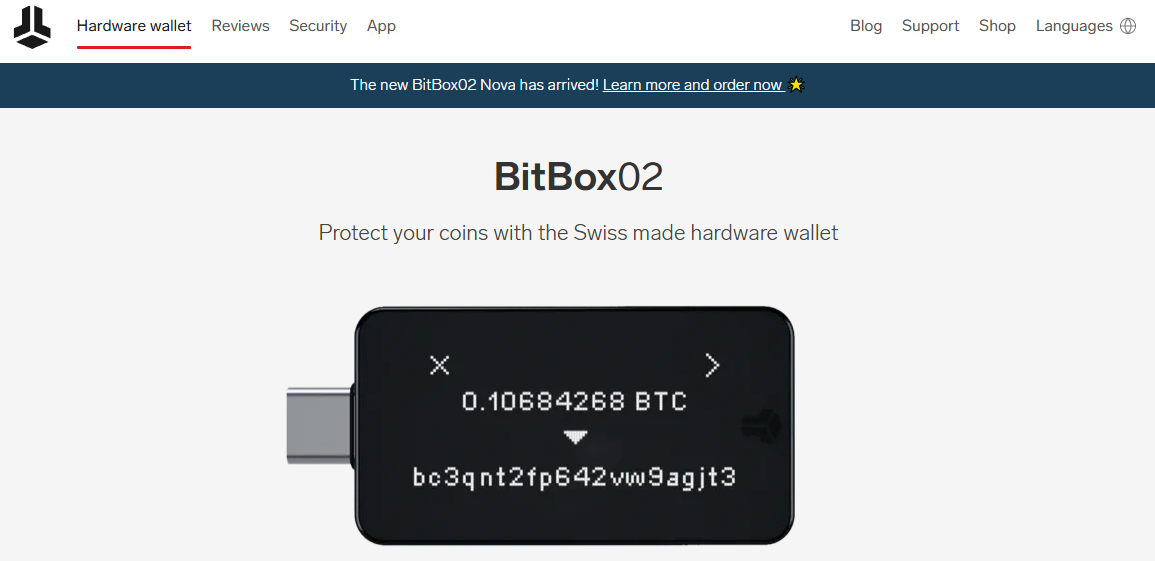
- Why Use It: Swiss-built, open-source, and elegantly simple, BitBox02 uses a secure chip plus epoxy potting and a microSD for fast, offline backups. It’s a great blend of transparent design and sane UX. bitbox.swiss+1
- Best For: Beginners who want a short setup, devs who value open code, travelers who like microSD backups.
- Notable Features: microSD backup/restore, dual-chip with secure element, open-source, in-app guide. bitbox.swiss
- Consider If: You need QR signing; look at Keystone or Passport.
- Alternatives: Trezor, Keystone
- Regions: Global
- Fees Notes: One-time device purchase.
4. COLDCARD (Mk4 / Q) — Best for Bitcoin-only, air-gapped PSBT
- Why Use It: Long favored by security maximalists, Coldcard is designed for fully air-gapped, PSBT-first workflows. Duress/tamper PINs, seed scrambling, and reproducible builds make it a fortress for BTC savings. coldcard.com+1
- Best For: Long-term Bitcoin cold storage, multisig operators, security pros.
- Notable Features: True air-gapped via MicroSD, PSBT (BIP174), anti-tamper features, duress/multisig tooling. coldcard.com
- Consider If: You need altcoins; choose Ledger, Trezor, or BitBox02.
- Alternatives: Passport, Jade
- Regions: Global
- Fees Notes: One-time device purchase.
5. Keystone 3 Pro — Best for QR signing across many chains
- Why Use It: Keystone focuses on fully air-gapped QR workflows—no USB, Bluetooth, Wi-Fi, or NFC—plus Shamir backups and strong multisig support. The 3 Pro adds three security chips and tight compatibility with leading wallet apps. keyst.one+1
- Best For: Multisig setups, DeFi users who prefer QR signing, mobile users.
- Notable Features: QR-only air-gap, multi-chip architecture, wide app compatibility, fingerprint unlock, large screen. keyst.one+1
- Consider If: You want a huge desktop screen (see Lattice1).
- Alternatives: Passport, Jade
- Regions: Global
- Fees Notes: One-time device purchase; optional accessories.
6. Blockstream Jade (Classic / Plus) — Best affordable open-source (Bitcoin & Liquid)
- Why Use It: Jade is open-source with optional air-gapped camera signing, Anti-Exfil, and a friendly app. It’s a strong value pick for Bitcoiners who still want modern conveniences like Bluetooth and battery power. blockstream.com
- Best For: Bitcoin users, Liquid asset holders, open-source fans.
- Notable Features: Camera for QR, air-gapped transactions, Anti-Exfil, Bluetooth, optional stateless mode. blockstream.com
- Consider If: You want more chains; consider Ledger/Trezor.
- Alternatives: COLDCARD, Passport
- Regions: Global
- Fees Notes: One-time device purchase.
7. GridPlus Lattice1 — Best for big screen review & SafeCards
- Why Use It: A 5" touchscreen and SafeCards make policy controls and multi-wallet management feel enterprise-grade. The Secure Enclave and card model are great for households, teams, or power users who hate “blind signing.” GridPlus+2docs.gridplus.io+2
- Best For: Institutions, multisig coordinators, collectors with many addresses.
- Notable Features: Large display, Secure Enclave, SafeCards for key portability/limits, policy rules, robust desktop UX. docs.gridplus.io
- Consider If: You want ultra-portable or budget under $150.
- Alternatives: Ledger Stax, Keystone
- Regions: Global
- Fees Notes: One-time device purchase; SafeCards sold separately.
8. Foundation Passport (Core) — Best for QR + Bitcoin privacy flows
- Why Use It: Passport emphasizes QR signing, clean UX, and Bitcoin-only focus. Thoughtful hardware (camera, microSD) and transparent docs make it a favorite for air-gapped, privacy-first workflows. Foundation+1
- Best For: Bitcoin-only users, privacy fans, QR-centric multisig.
- Notable Features: QR signing, microSD for firmware/PSBT, premium build, open-source ethos. docs.foundation.xyz
- Consider If: You need altcoins/EVM—choose Ledger or Keystone.
- Alternatives: COLDCARD, Jade
- Regions: Global
- Fees Notes: One-time device purchase.
9. SafePal S1 / S1 Pro — Best budget air-gapped option
- Why Use It: SafePal delivers QR-based, fully air-gapped signing with a Secure Element (CC EAL6+) at a very accessible price point, plus a companion app for swaps and DeFi. Great for newcomers who still want true offline signing. safepal.com+1
- Best For: Budget buyers, mobile users, “first hardware wallet.”
- Notable Features: QR signing, Secure Element (EAL6+), self-destruct/anti-tamper, rich app integrations. safepal.com
- Consider If: You prefer fully open-source firmware (see Trezor/BitBox/Jade).
- Alternatives: Tangem, Ledger Nano S Plus
- Regions: Global
- Fees Notes: One-time device purchase; in-app services may incur fees.
10. Tangem Wallet (2- or 3-card set) — Best card-based, seedless recovery model
- Why Use It: Tangem uses NFC cards with an EAL6+ secure chip and a 25-year warranty, removing seed phrases in favor of multi-card backups. Tap-to-sign is intuitive, and the rugged, battery-free design suits travel and daily carry. Tangem
- Best For: Everyday spenders, beginners who fear seed phrases, travelers.
- Notable Features: Seedless multi-card backup, EAL6+ chip, IP69K-rated durability, NFC tap-to-sign, long warranty. Tangem
- Consider If: You want a traditional BIP39 seed and broad third-party wallet support.
- Alternatives: SafePal S1, Keystone
- Regions: Global
- Fees Notes: One-time card set; no charging required.
Decision Guide: Best By Use Case
- Broad multi-chain + best ecosystem: Ledger
- Fully open-source first: Trezor, BitBox02, Blockstream Jade
- Bitcoin-only vaulting: COLDCARD, Passport, Jade
- QR / air-gapped multisig: Keystone, Passport, Jade
- Large screen & team workflows: GridPlus Lattice1
- Budget under $100 (often): SafePal S1, Jade (promos), Trezor Safe 3
- Seedless, card-based: Tangem
- Mobile/Bluetooth convenience: Ledger Nano X, Jade
How to Choose the Right Hardware Wallet (Checklist)
- Confirm security model: Secure Element, open-source, air-gap/QR, PSBT.
- Match coverage to your assets (BTC-only vs multi-chain/EVM/Solana).
- Check ecosystem access: companion app, 3rd-party wallet support.
- Weigh UX: screen size, buttons/touch, Bluetooth, mobile pairing.
- Review recovery: BIP39/Shamir vs seedless cards; where you’ll store backups.
- Validate firmware cadence and support.
- Red flags: blind-signing unclear data; closed update channels; no documented security page.
Use Token Metrics With Any Hardware Wallet
Turn cold storage into a smarter strategy:
- AI Ratings to screen tokens you plan to hold.

- Narrative Detection to catch momentum early.
- Portfolio Optimization to size positions and balance risk.
- Alerts & Signals to monitor entries/exits—without moving your keys.
Workflow: Research on Token Metrics → Pick assets → Acquire & secure with your wallet → Track performance + alerts.
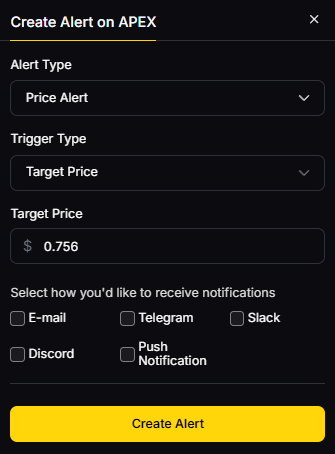
Primary CTA: Start free trial

Security & Compliance Tips
- Enable PIN + passphrase (where supported) and store backups offline.
- Prefer air-gapped/QR or PSBT flows for high-value moves.
- Verify addresses and amounts on-device; avoid blind signing.
- Keep firmware up to date; download only from official sources.
- Separate daily hot spending from long-term cold storage.
This article is for research/education, not financial advice.
Beginner Mistakes to Avoid
- Keeping the only seed phrase in a single location.
- Re-using the same device for testnets and main funds.
- Blind-signing smart-contract approvals you don’t understand.
- Leaving device uninitialized/unpinned in a desk drawer.
- Buying from unofficial marketplaces or “pre-set up” resellers.
FAQs
What is a hardware wallet?
A hardware wallet is a physical device that stores private keys and authorizes transactions offline, reducing exposure to malware and phishing compared to software wallets.
Do I need a hardware wallet if I use a centralized exchange?
If an exchange is hacked or freezes withdrawals, you can lose access. A hardware wallet lets you self-custody, so you control keys and recovery—many users keep long-term holdings in cold storage and only move funds when needed.
Is a Secure Element required?
Not required, but many devices use a CC EAL5+/EAL6+ Secure Element to resist physical extraction. Open-source firmware and verifiable builds also matter—evaluate the whole model, not just one spec. Ledger
What’s the difference between air-gapped QR and USB/Bluetooth?
QR/PSBT keeps signing data offline via camera or microSD. USB/Bluetooth devices can still be safe if the secret keys never leave the secure chip and screens verify data—choose the flow you’ll actually use correctly. coldcard.com+1
Can I use one wallet for multiple chains?
Yes—multi-chain devices (e.g., Ledger, Trezor, Keystone) support many networks. Bitcoin-focused devices (COLDCARD, Passport, Jade) prioritize BTC security and workflows.
How often should I rotate or back up?
Back up at setup, test recovery once, and review backups quarterly. Rotate seeds if you suspect exposure, or after major life changes.
Conclusion + Related Reads
If you want the widest ecosystem, Ledger is tough to beat. Prefer open-source? Trezor or BitBox02 are excellent defaults. For Bitcoin vaulting, COLDCARD, Jade, or Passport shine. Need team or household management? Lattice1. Budget-friendly air-gap? SafePal. Seedless and ultra-portable? Tangem.
Pick a model you’ll use correctly—then let Token Metrics guide what goes inside it.
Related Reads:
- Best Cryptocurrency Exchanges 2025
- Top Derivatives Platforms 2025
- Top Institutional Custody Providers 2025

Top Institutional Custody Providers (2025)
%201.svg)
%201.svg)
Why Institutional Crypto Custody Providers Matter in September 2025
Institutional custody is the backbone of professional digital-asset operations. The right institutional custody provider can safeguard private keys, segregate client assets, streamline settlement, and enable workflows like staking, financing, and governance. In one sentence: an institutional crypto custodian is a regulated organization that safekeeps private keys and operationalizes secure asset movements for professional clients. In 2025, rising ETF inflows, tokenization pilots, and on-chain settlement networks make safe storage and compliant operations non-negotiable. This guide is for funds, treasuries, brokers, and corporates evaluating digital asset custody partners across the US, EU, and APAC. We compare security posture, regulatory status (e.g., qualified custodian where applicable), asset coverage, fees, and enterprise UX—so you can shortlist fast and execute confidently.
How We Picked (Methodology & Scoring)
- Liquidity (30%): Depth/venues connected, settlement rails, prime/brokerage adjacency.
- Security (25%): Key management (HSM/MPC), offline segregation, audits/SOC reports, insurance disclosures.
- Coverage (15%): Supported assets (BTC/ETH + long tail), staking, tokenized products.
- Costs (15%): Transparent billing, AUC bps tiers, network fee handling, minimums.
- UX (10%): Console quality, policy controls, APIs, reporting.
- Support (5%): White-glove ops, SLAs, incident response, onboarding speed.
Data sources: Official product/docs, trust/security pages, regulatory/licensing pages, and custodian legal/fee disclosures. Market size/sentiment cross-checked with widely cited datasets; we did not link third parties in-body.
Last updated September 2025.
Top 10 Institutional Crypto Custody Providers in September 2025
1. Coinbase Prime Custody — Best for US-regulated scale
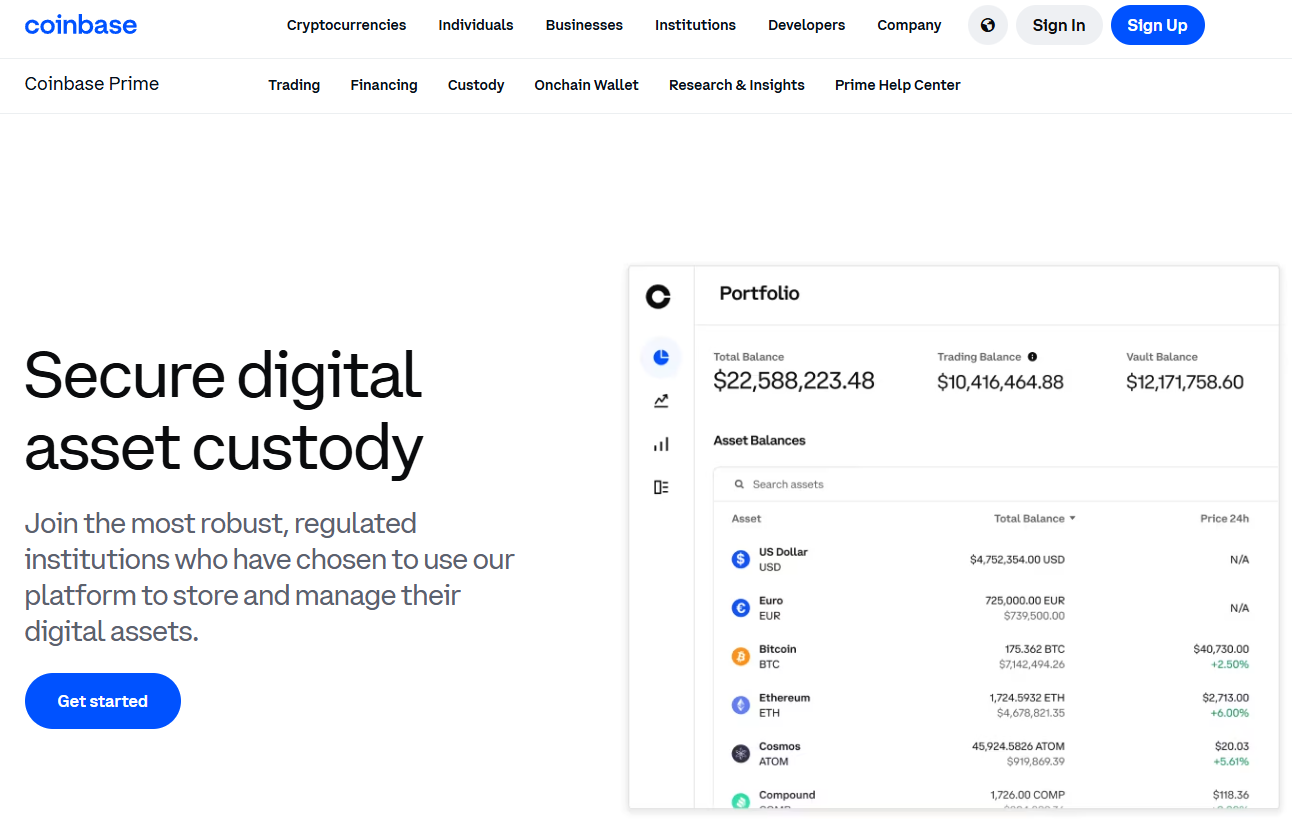
Why Use It: Coinbase Custody Trust Company is a NY state-chartered trust and qualified custodian, integrated with Prime trading, staking, and Web3 workflows. Institutions get segregated cold storage, SOC 1/2 audits, and policy-driven approvals within a mature prime stack. Coinbase+2Coinbase+2
Best For: US managers, ETF service providers, funds/treasuries that need deep liquidity + custody.
Notable Features:
- Qualified custodian (NY Banking Law) with SOC 1/2 audits
- Vault architecture + policy engine; Prime integration
- Staking and governance support via custody workflows Coinbase+1
Consider If: You want a single pane for execution and custody with US regulatory clarity.
Alternatives: Fidelity Digital Assets, BitGo
Fees/Notes: Enterprise bps on AUC; network fees pass-through.
Regions: US/Global (eligibility varies).
2. Fidelity Digital Assets — Best for traditional finance ops rigor

Why Use It: A division of Fidelity with an integrated custody + execution stack designed for institutions, offering cold-storage execution without moving assets and traditional operational governance. Fidelity Digital Assets+1
Best For: Asset managers, pensions, corporates seeking a blue-chip brand and conservative controls.
Notable Features:
- Integrated custody + multi-venue execution
- Operational governance and reporting ethos from TradFi
- Institutional research and coverage expansion Fidelity Digital Assets+1
Consider If: You prioritize a legacy financial brand with institutional processes.
Alternatives: BNY Mellon, Coinbase Prime
Fees/Notes: Bespoke enterprise pricing.
Regions: US/EU (eligibility varies).
3. BitGo Custody — Best for multi-jurisdiction options
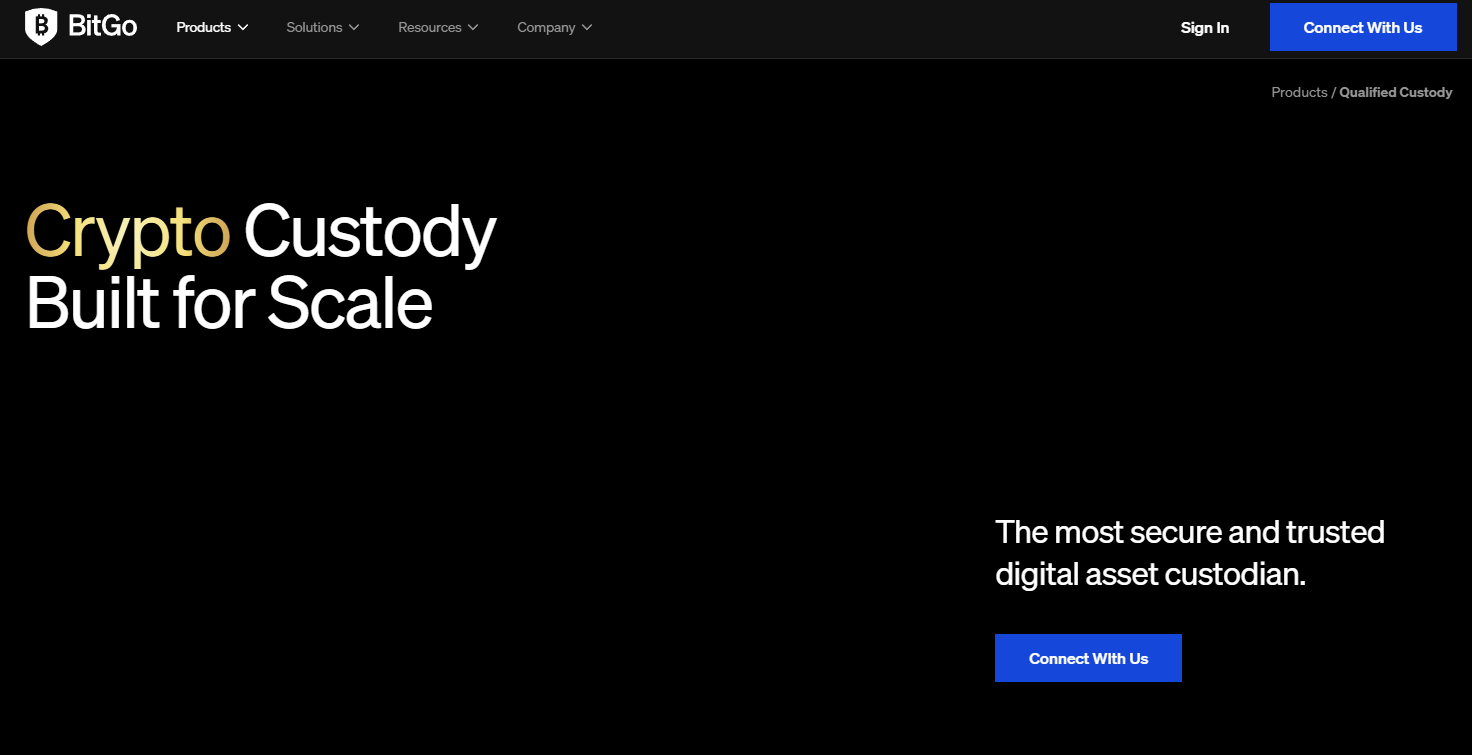
Why Use It: BitGo operates qualified custody entities with coverage across North America, EMEA, and APAC, plus robust policy controls and detailed billing methodology for AUC. The Digital Asset Infrastructure Company+1
Best For: Funds, market makers, and enterprises needing global entity flexibility.
Notable Features:
- Qualified custodian entities; segregated wallets
- Rich policy tooling and operational controls
- Transparent AUC billing methodology (bps) The Digital Asset Infrastructure Company
Consider If: You need multi-region setup or bespoke operational segregation.
Alternatives: Komainu, Zodia Custody
Fees/Notes: Tiered AUC bps; bespoke network ops. The Digital Asset Infrastructure Company
Regions: US/EU/APAC/MENA.
4. Anchorage Digital Bank — Best for federal bank oversight
Why Use It: The only crypto-native bank with an OCC charter in the US; a qualified custodian with staking and governance alongside institutional custody. Anchorage+1
Best For: US institutions that want bank-level oversight and crypto-native tech.
Notable Features:
- OCC-chartered bank; qualified custodian
- Staking across major PoS assets
- Institutional console + policy workflows Anchorage+1
Consider If: You need federal oversight and staking inside custody.
Alternatives: Coinbase Prime Custody, Fidelity Digital Assets
Fees/Notes: Enterprise pricing; staking terms by asset.
Regions: US (select global clients).
5. BNY Mellon Digital Asset Custody — Best for global bank infrastructure
Why Use It: America’s oldest bank runs an institutional Digital Assets Platform for safekeeping and on-chain services, built on its global custody foundation—ideal for asset-servicing integrations. BNY+1
Best For: Asset servicers, traditional funds, and banks needing large-scale controls.
Notable Features:
- Integrated platform for safekeeping/servicing
- Bank-grade controls and lifecycle tooling
- Enterprise reporting and governance BNY
Consider If: You prefer a global bank custodian with mature ops.
Alternatives: Fidelity Digital Assets, Sygnum Bank
Fees/Notes: Custom; bank service bundles.
Regions: US/EU (eligibility varies).
6. Gemini Custody — Best for security-first cold storage
Why Use It: Gemini Trust Company is a NY-chartered fiduciary and qualified custodian with air-gapped cold storage, role-based governance, and SOC reports—plus optional insurance coverage for certain assets. Gemini+1
Best For: Managers and corporates prioritizing conservative cold storage.
Notable Features:
- Qualified custodian; segregated cold storage
- Role-based governance and biometric access
- Broad supported-asset list Gemini
Consider If: You need straightforward custody without bundled trading.
Alternatives: BitGo, Coinbase Prime Custody
Fees/Notes: Tailored plans; network fees apply.
Regions: US/Global (eligibility varies).
7. Komainu — Best for regulated multi-hub custody (Jersey/UK/UAE/EU)
Why Use It: Nomura-backed Komainu operates regulated custody with segregation and staking, supported by licenses/registrations across Jersey, the UAE (Dubai VARA), the UK, and Italy—useful for cross-border institutions. Komainu+1
Best For: Institutions needing EMEA/Middle East optionality and staking within custody.
Notable Features:
- Regulated, segregated custody
- Institutional staking from custody
- Governance & audit frameworks Komainu+1
Consider If: You require multi-jurisdiction regulatory coverage.
Alternatives: Zodia Custody, BitGo
Fees/Notes: Enterprise pricing on request.
Regions: EU/UK/Middle East (global eligibility varies).
8. Zodia Custody — Best for bank-backed, multi-license EMEA coverage
Why Use It: Backed by Standard Chartered, Zodia provides institutional custody with air-gapped cold storage, standardized controls, and licensing/registrations across the UK, Ireland, Luxembourg, and Abu Dhabi (ADGM). zodia-custody.com+1
Best For: Asset managers and treasuries seeking bank-affiliated custody in EMEA.
Notable Features:
- Air-gapped cold storage & policy controls
- Multi-region regulatory permissions (EMEA/MENA)
- Institutional onboarding and reporting zodia-custody.com
Consider If: You want bank-backed governance and EU/Middle East reach.
Alternatives: Komainu, BNY Mellon
Fees/Notes: Custom pricing.
Regions: UK/EU/MENA/APAC (per license/authorization).
9. Sygnum Bank — Best for Swiss banking-grade custody + settlement network
Why Use It: FINMA-regulated Swiss bank providing off-balance-sheet crypto custody, staking, and Sygnum Connect—a 24/7 instant settlement network for fiat, crypto, and stablecoins. Sygnum Bank+1
Best For: EU/Asia institutions valuing Swiss regulation and bank-grade controls.
Notable Features:
- Off-balance-sheet, ring-fenced custody
- Staking from custody and asset risk framework
- Instant multi-asset settlement (Sygnum Connect) Sygnum Bank+1
Consider If: You want Swiss regulatory assurances + 24/7 settlement.
Alternatives: AMINA Bank, BNY Mellon
Fees/Notes: AUC bps; see price list. Sygnum Bank
Regions: EU/APAC (CH/SG).
10. Hex Trust — Best for APAC institutions with MAS-licensed stack
Why Use It: A fully licensed APAC custodian offering on-chain segregation, role-segregated workflows, staking, and—in 2025—obtained a MAS Major Payment Institution license to offer DPT services in Singapore, rounding out custody + settlement. Hex Trust+1
Best For: Funds, foundations, and corporates across Hong Kong, Singapore, and the Middle East.
Notable Features:
- On-chain segregated accounts; auditability
- Policy controls with granular sub-accounts
- Staking & integrated markets services Hex Trust
Consider If: You want APAC-native licensing and operational depth.
Alternatives: Sygnum Bank, Komainu
Fees/Notes: Enterprise pricing; insurance program noted. Hex Trust
Regions: APAC/Middle East (licensing dependent).
Decision Guide: Best By Use Case
- US-regulated & ETF-adjacent: Coinbase Prime Custody; Anchorage Digital Bank; Fidelity Digital Assets. Coinbase+2Anchorage+2
- Bank-backed in EMEA: BNY Mellon; Zodia Custody. BNY+1
- Multi-jurisdiction flexibility: BitGo; Komainu. The Digital Asset Infrastructure Company+1
- Swiss banking model: Sygnum Bank (and consider AMINA Bank). Sygnum Bank
- APAC-first compliance: Hex Trust. Hex Trust
- Cold-storage emphasis with simple pricing: Gemini Custody. Gemini
How to Choose the Right Institutional Custody Provider (Checklist)
- Regulatory fit: Qualified custodian or bank charter where required by your advisors/LPAs.
- Asset coverage: BTC/ETH + the specific long-tail tokens or staking assets you need.
- Operational controls: Policy rules, role segregation, whitelists, hardware/MPC key security.
- Settlement & liquidity: RFQ/OTC rails, prime integration, or instant networks.
- Fees: AUC bps, network fee handling, staking commissions, onboarding costs. The Digital Asset Infrastructure Company
- Reporting & audit: SOC attestations, proof of segregated ownership, audit trails. Coinbase
- Support: 24/7 ops desk, SLAs, incident processes.
- Red flags: Commingled wallets, unclear ownership/legal structure, limited disclosures.
Use Token Metrics With Any Custodian
- AI Ratings: Screen assets with on-chain + quant scores to narrow to high-conviction picks.
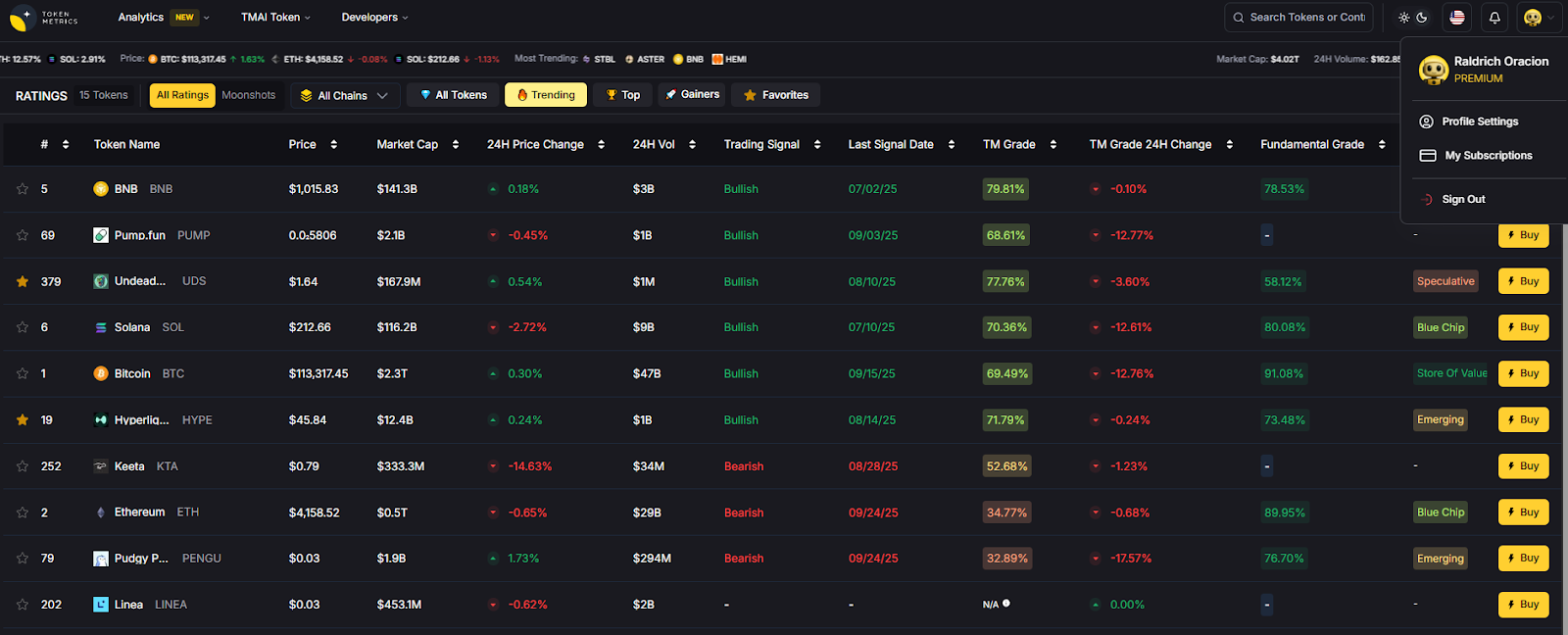
- Narrative Detection: Identify sector momentum early (L2s, RWAs, staking).
- Portfolio Optimization: Balance risk/return before you allocate from custody.
- Alerts & Signals: Monitor entries/exits and risk while assets stay safekept.
Workflow (1–4): Research in Token Metrics → Select assets → Execute via your custodian’s trading rails/prime broker → Monitor with TM alerts.

Primary CTA: Start free trial.

Security & Compliance Tips
- Enforce hardware/MPC key ceremonies and multi-person approvals.
- Use role-segregated policies and allowlisting for withdrawals.
- Align KYC/AML and travel-rule workflows with fund docs and auditors.
- Document staking/airdrop entitlements and slashing risk treatment.
- Keep treasury cold storage separate from hot routing wallets.
This article is for research/education, not financial advice.
Beginner Mistakes to Avoid
- Picking a non-qualified entity when your mandate requires a qualified custodian.
- Underestimating operational lift (approvals, whitelists, reporting).
- Ignoring region-specific licensing/eligibility limitations. Hex Trust+1
- Focusing only on fees without evaluating security controls.
- Mixing trading and custody without strong policy separation.
FAQs
What is a qualified custodian in crypto?
A qualified custodian is a regulated entity (e.g., trust company or bank) authorized to hold client assets with segregation and audited controls, often required for investment advisers. Look for clear disclosures, SOC reports, and trust/bank charters on official pages. Coinbase+1
Do I need a qualified custodian for my fund?
Many US advisers and institutions require qualified custody under their compliance frameworks; your legal counsel should confirm. When in doubt, choose a trust/bank chartered provider with documented segregation and audits. Coinbase
Which providers support staking from custody?
Anchorage, Coinbase Prime, Komainu, Sygnum, and Hex Trust offer staking workflows from custody (asset lists vary). Confirm asset-by-asset support and commissions. Hex Trust+4Anchorage+4Coinbase+4
How are fees structured?
Most providers price custody in annualized basis points (bps) on average assets under custody; some publish methodologies or fee schedules. Network fees are usually passed through. The Digital Asset Infrastructure Company
Can I keep assets off-exchange and still trade?
Yes—prime/custody integrations and instant-settlement networks let you trade while keeping keys in custody, reducing counterparty risk. Examples include Coinbase Prime and Sygnum Connect. Coinbase+1
Are there regional restrictions I should know about?
Licensing/availability varies (e.g., Hex Trust operates under MAS MPI in Singapore; Zodia holds permissions across UK/EU/ADGM). Always confirm eligibility for your entity and region. Hex Trust+1
Conclusion + Related Reads
If you operate in the US with strict compliance needs, start with Coinbase Prime, Fidelity, or Anchorage. For bank-backed EMEA coverage, look to BNY Mellon or Zodia. For Swiss banking controls and instant settlement, Sygnum stands out; in APAC, Hex Trust offers strong licensing and workflows. BitGo and Komainu excel when you need multi-jurisdiction flexibility.
Related Reads:
- Best Cryptocurrency Exchanges 2025
- Top Derivatives Platforms 2025
- Top Institutional Custody Providers 2025

Best Retail Crypto Wallets (Mobile/Web) 2025
%201.svg)
%201.svg)
Why Retail Crypto Wallets (Mobile/Web) Matter in September 2025
Retail-friendly mobile and web wallets make crypto usable—on your phone and in your browser—without relying on a centralized custodian. This guide ranks the best retail crypto wallets for 2025 so you can safely store, send, swap, and explore Web3. A crypto wallet is software that holds your keys and lets you sign transactions; self-custody means you control those keys.
We focus on practical needs: everyday buys, swaps, NFT viewing, multi-chain coverage, and clear fees. Expect mainstream names alongside rising multichain players. Secondary considerations include mobile crypto wallet UX, web3 wallet dapp access, and self-custody wallet security. If you’re new, start with a wallet that offers simple onboarding and robust recovery. If you’re advanced, look for pre-transaction risk checks, multichain swaps, and hardware support.
How We Picked (Methodology & Scoring)
- Liquidity (30%) – depth and routing quality for in-wallet swaps/bridging; reliable asset movement.
- Security (25%) – self-custody design, audits, MPC/multisig options, hardware compatibility, recovery.
- Coverage (15%) – number of supported chains/tokens and NFT handling.
- Costs (15%) – transparent swap/bridge fees and gas handling.
- UX (10%) – onboarding, performance, transaction clarity, portfolio/NFT views.
- Support (5%) – docs, help centers, in-app support channels.
Sources: official product/docs pages, security/transparency pages, and (for cross-checks only) reputable market datasets. Last updated: September 2025.
Top 10 Retail Crypto Wallets (Mobile/Web) in September 2025
1. MetaMask — Best for EVM & massive dapp coverage

Why Use It: The most ubiquitous Web3 wallet, MetaMask balances power and familiarity. It’s everywhere dapps are, with mobile + browser extension, good network support, and strong swap/bridge routing in-app. Smart Transactions and built-in security alerts improve reliability for everyday users. MetaMask
Best For: EVM users, NFT collectors, L2 explorers, DeFi regulars.
Notable Features: Smart Transactions; Swaps/Bridge aggregator; MetaMask Learn; mobile + major browsers. MetaMask+1
Consider If: You want explicit fee transparency—MetaMask Swaps includes a 0.875% service fee (plus network gas). MetaMask Help Center
Alternatives: Trust Wallet, OKX Wallet.
Regions: Global.
Fees Notes: Network fees; MetaMask Swaps service fee 0.875%. MetaMask Help Center
2. Trust Wallet — Best all-rounder for mobile + extension
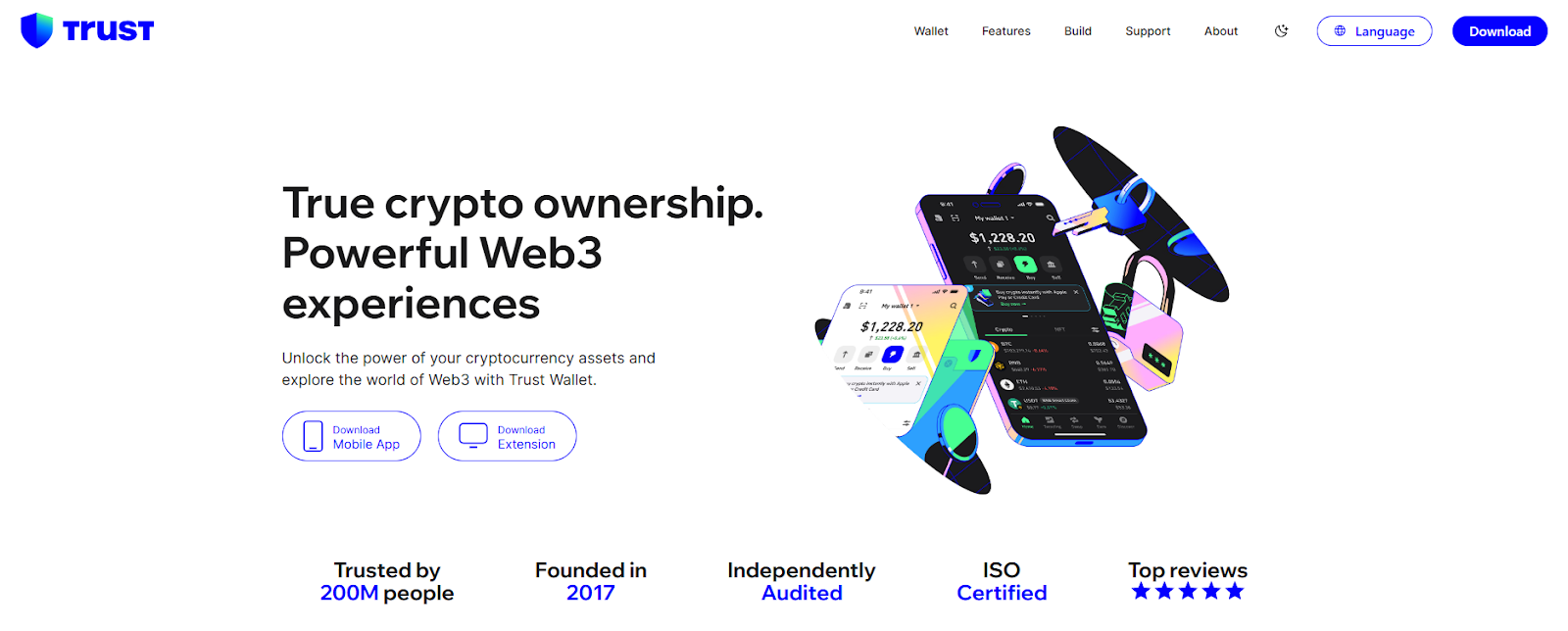
Why Use It: Trust Wallet offers a simple, one-stop experience: buy, send, swap, stake, and manage NFTs across many chains. Its mobile app is fast, and the extension integrates with popular EVM and non-EVM chains. Trust Wallet+1
Best For: Beginners who want breadth; multichain NFT holders; mobile-first users.
Notable Features: Built-in DApp browser; simplified swaps with gas optimization; staking flows. Trust Wallet
Consider If: You want no added swap fee—Trust says it doesn’t charge extra on swaps (you still pay network/third-party fees). Trust Wallet
Alternatives: MetaMask, Crypto.com Onchain.
Regions: Global.
Fees Notes: Network/partner fees apply; Trust states no added in-app swap fee. Trust Wallet
3. Base app (formerly Coinbase Wallet) — Best for Coinbase ecosystem & onchain social
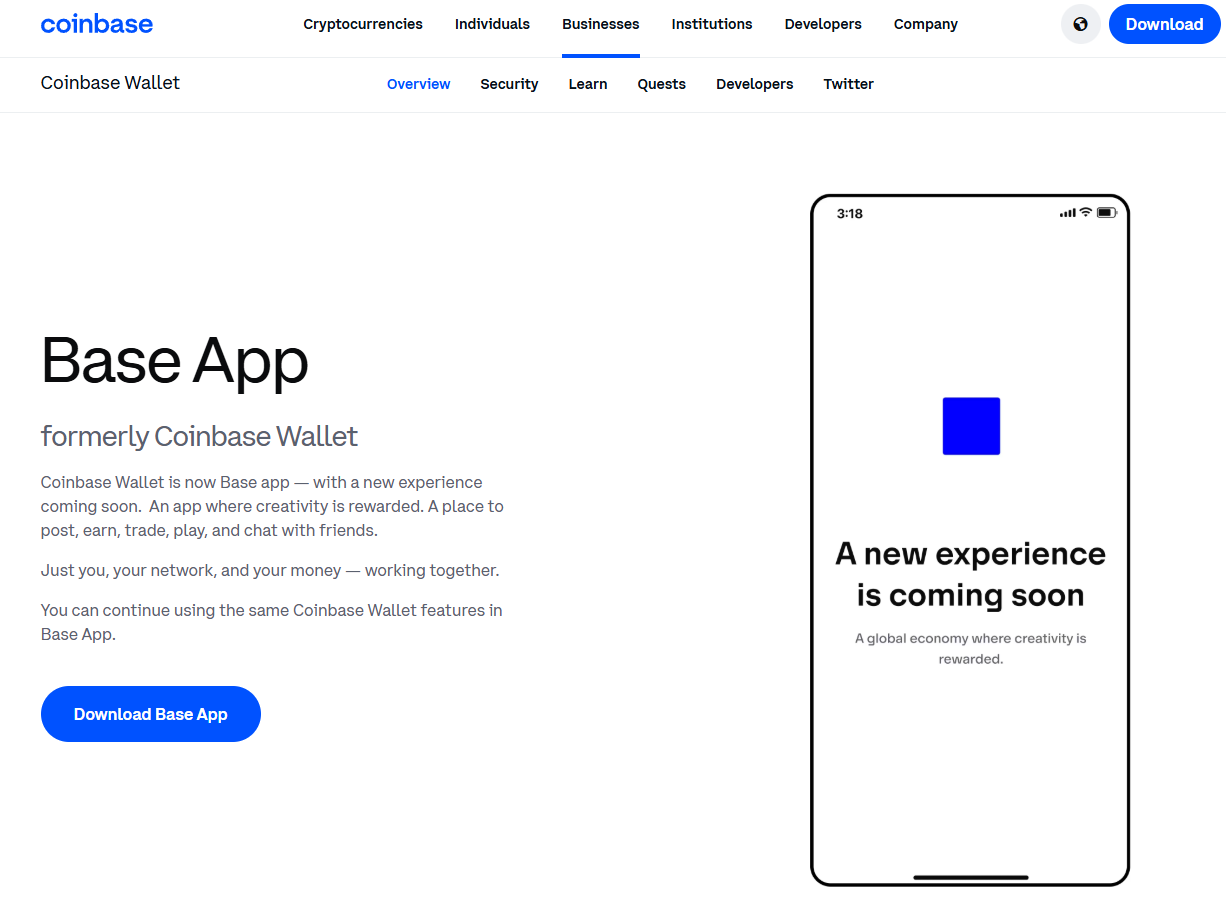
Why Use It: Rebranded as the Base app, the former Coinbase Wallet keeps familiar self-custody features while embracing Base/L2 culture and onchain social/activity. If you already use Coinbase products, onboarding is straightforward while staying self-custodial. Coinbase
Best For: Coinbase users going self-custody; Base/L2 explorers; web3 social/NFT dabblers.
Notable Features: Self-custody; trading, posting, playing; continuity for Coinbase Wallet users. Coinbase
Consider If: You prefer chain-agnostic advanced tooling—others may offer deeper multichain utilities today.
Alternatives: MetaMask, Rainbow.
Regions: Global.
Fees Notes: Network fees; third-party swap/partner fees where used. Coinbase
4. Phantom — Best for Solana + solid multichain UX
Why Use It: Phantom started Solana-first and has grown into a polished multichain wallet (Solana, Ethereum, and more). The interface is clean, with strong NFT views and transaction clarity—great for newcomers to Solana and cross-chain dabblers. Phantom+1
Best For: Solana users, NFT traders, multichain retail.
Notable Features: In-wallet swaps and bridging; gasless swaps on Solana (select cases); robust notifications/history. Phantom Support+1
Consider If: You want the lowest possible swap fees—Phantom lists 0.85% on select pairs, with separate gas/bridge fees. Phantom Support
Alternatives: OKX Wallet, Trust Wallet.
Regions: Global.
Fees Notes: Network fees; Phantom fee 0.85% on select swaps; gasless-swap fee rules apply on Solana. Phantom Support+1
5. OKX Wallet — Best for power users who want DEX depth
Why Use It: OKX Wallet (extension + mobile) plugs you into OKX’s DEX aggregator, NFT marketplace, and DeFi. It offers multiple swap modes and solid routing—useful when chasing best execution across chains. OKX Wallet+1
Best For: DeFi users seeking liquidity routing; cross-chain swappers; NFT traders.
Notable Features: Multi-mode swaps; DEX aggregator; marketplace; Earn/Discover sections. OKX Wallet
Consider If: You need crystal-clear fee schedules—OKX lists DEX interface fee tiers up to 0.85% depending on pair groups. OKX Wallet
Alternatives: MetaMask, Bitget Wallet.
Regions: Global (wallet).
Fees Notes: Network fees; OKX DEX interface fee 0–0.85% by pair category. OKX Wallet
6. Exodus — Best for design & easy portfolio views
Why Use It: Exodus is a long-standing, self-custodial wallet with a beautifully designed UI across desktop and mobile. Portfolio tracking and NFT galleries are polished, and its Web3 Wallet extends multichain support. Exodus
Best For: Newcomers who want clarity; portfolio-first users; multi-device use.
Notable Features: Multichain Web3 Wallet; thousands of swap pairs; simple buy/sell integrations. Exodus
Consider If: You want explicit fee details—Exodus doesn’t charge send/receive wallet fees, but network and partner fees still apply. Exodus Knowledge Base
Alternatives: Crypto.com Onchain, ZenGo.
Regions: Global.
Fees Notes: No Exodus send/receive fees; network fees + third-party swap/fiat fees may apply. Exodus Knowledge Base
7. Crypto.com Onchain — Best for simple multichain + Crypto.com tie-ins
Why Use It: Formerly known as the DeFi Wallet experience, Crypto.com Onchain is a self-custodial app with multichain support, in-wallet trading, and dapp access. It’s friendly for users who like Crypto.com’s ecosystem but want self-custody keys. Crypto.com
Best For: Mobile-first users; staking/earn explorers; Crypto.com ecosystem fans.
Notable Features: Local key encryption; import via 12/18/24-word phrases; multichain trading & dapp browser. Crypto.com
Consider If: You prefer a purely chain-agnostic wallet without exchange brand ties—others may feel “lighter.”
Alternatives: Trust Wallet, Exodus.
Regions: Global (feature availability can vary).
Fees Notes: Network/partner fees; self-custody (no custodial withdrawal fees). Crypto.com
8. ZenGo — Best for seed-phrase-free MPC security
Why Use It: ZenGo uses MPC to remove single-point seed phrase risks while keeping you in self-custody. That makes setup and recovery less nerve-wracking for new users, without buying hardware. Zengo+1
Best For: Beginners prioritizing recovery; mobile-only users; security-conscious travelers.
Notable Features: Seed-phrase-free MPC; in-app buy/swap; staking for select assets. Zengo+1
Consider If: You want classic seed control or advanced on-chain tooling—some power features are simpler by design.
Alternatives: Ledger Live (with hardware), Trust Wallet.
Regions: Global.
Fees Notes: Network fees; partner fees for buy/swap as quoted in-app. Zengo
9. Bitget Wallet — Best for active swappers & airdrop hunters
Why Use It: Formerly BitKeep, Bitget Wallet has grown into a large multichain wallet with DEX aggregation, dapp discovery, and memecoin-friendly flows. It’s geared for on-chain traders who want routing and token coverage across 65+ chains. Bitget Wallet+1
Best For: Power users in DeFi; memecoin and airdrop participants; cross-chain swaps.
Notable Features: Multichain DEX aggregator; dapp hub; iOS/Android + Chrome extension. Bitget Wallet
Consider If: You prefer a simpler, beginner-first interface—others above are more hand-holding.
Alternatives: OKX Wallet, MetaMask.
Regions: Global.
Fees Notes: Network fees; interface/partner fees vary by route/pair. Bitget Wallet
10. Ledger Live — Best for hardware-backed mobile/desktop security
Why Use It: Ledger Live is the companion app to Ledger hardware wallets; it brings buy, swap, stake, and portfolio monitoring into a single interface while private keys stay in the hardware device. Great for retail users who want a mobile/desktop app but insist on offline signing. Ledger
Best For: Long-term holders; high-value accounts; users planning to add hardware.
Notable Features: Buy/sell/swap/stake modules; multi-asset support; iOS/Android + desktop. Google Play+1
Consider If: You don’t own hardware—full security benefits require a Ledger device.
Alternatives: ZenGo (MPC), Trezor Suite (with hardware).
Regions: Global.
Fees Notes: Network fees; partner fees for buy/swap as quoted in-app. Ledger
Decision Guide: Best By Use Case
- Regulated U.S. on-ramp familiarity: Base app (formerly Coinbase Wallet)
- Global multichain coverage + liquidity routing: OKX Wallet, Bitget Wallet
- Solana-first with smooth UX: Phantom
- EVM & dapp coverage: MetaMask
- Mobile simplicity (no seed phrase): ZenGo
- Polished design & portfolio tracking: Exodus
- Exchange-brand ecosystem, self-custody keys: Crypto.com Onchain
- Hardware-secured flows: Ledger Live
- Beginner-friendly all-rounder: Trust Wallet
How to Choose the Right Retail Crypto Wallet (Checklist)
- Confirm eligibility/availability in your region and app store.
- Verify chain coverage (BTC + your primary L1s/L2s).
- Decide on custody model: classic seed, MPC (no seed), or hardware-backed.
- Review fees: swap/bridge interface fees + network gas.
- Evaluate UX: transaction previews, risk alerts, NFT view, portfolio.
- Check support: searchable help center, in-app ticketing.
- Compliance fit: consider your tax/KYC needs with on-ramps.
- Red flags: fake download pages; apps that ask you to type your seed phrase into a website or pop-up.
Use Token Metrics With Any Wallet
- AI Ratings to screen assets by quality and momentum.

- Narrative Detection to spot early theme shifts.
- Portfolio Optimization to balance risk across chains.
- Alerts & Signals to monitor entries/exits.
Workflow: Research → Select wallet → Execute on-chain → Monitor with alerts.\

Primary CTA: Start free trial

Security & Compliance Tips
- Enable biometrics + 2FA (where available) and set a strong passcode.
- Back up recovery materials: seed phrase metal card, or MPC recovery kits.
- Prefer hardware signing for larger balances.
- Use transaction previews and simulation/risk checks before signing.
- Keep software updated; download only from official sites/app stores.
This article is for research/education, not financial advice.
Beginner Mistakes to Avoid
- Saving seed phrases in cloud notes/screenshots.
- Sending coins to the wrong chain or address format.
- Ignoring fee settings or slippage in swaps.
- Approving unlimited token allowances without review.
- Falling for phishing domains and fake extensions.
FAQs
What is a retail crypto wallet (mobile/web)?
A mobile/web retail wallet is software that stores your private keys and lets you sign transactions from your phone or browser. Most are self-custodial, meaning you—not an exchange—control your keys.
Is a self-custody wallet safer than keeping coins on an exchange?
Self-custody removes exchange counterparty risk. However, you must protect recovery methods (seed phrase, MPC recovery) and your device. Hardware or MPC-based options can add protection.
Which wallet is best for beginners?
For simplicity: Trust Wallet, Exodus, or ZenGo. They have straightforward onboarding, clear portfolio views, and solid docs. Advanced users might prefer MetaMask, Phantom, or OKX Wallet for deeper on-chain tooling. OKX Wallet+5Trust Wallet+5Exodus+5
What fees should I expect?
You’ll always pay network gas. Some wallets add interface/service fees on swaps/bridges (e.g., MetaMask 0.875%; Phantom 0.85% on select pairs; OKX DEX 0–0.85% depending on token groups). MetaMask Help Center+2Phantom Support+2
Do I need hardware for mobile/web wallets?
No. Many work fine without hardware. For higher balances, pairing a mobile/web app with a hardware wallet (e.g., via Ledger Live) can reduce signing risk. Ledger
Can I use one wallet across multiple chains?
Yes—most featured wallets are multichain. Check chain lists and NFT support before migrating. OKX Wallet+2Bitget Wallet+2
Conclusion + Related Reads
If you want maximum dapp coverage, go MetaMask; Solana-centric with great UX, pick Phantom; for exchange-adjacent simplicity, choose Base app or Crypto.com Onchain; for hardware-backed security, Ledger Live. Power users chasing routing and airdrops may prefer OKX Wallet or Bitget Wallet, while newcomers should consider Trust Wallet, Exodus, or ZenGo.
Related Reads:
- Best Cryptocurrency Exchanges 2025
- Top Derivatives Platforms 2025
- Top Institutional Custody Providers 2025


Get Your Brand in Front of 150,000+ Crypto Investors!




 Create Your Free Account
Create Your Free Account9450 SW Gemini Dr
PMB 59348
Beaverton, Oregon 97008-7105 US
.svg)
No Credit Card Required


Online Payment


SSL Encrypted
.png)
Products
Subscribe to Newsletter
Token Metrics Media LLC is a regular publication of information, analysis, and commentary focused especially on blockchain technology and business, cryptocurrency, blockchain-based tokens, market trends, and trading strategies.
Token Metrics Media LLC does not provide individually tailored investment advice and does not take a subscriber’s or anyone’s personal circumstances into consideration when discussing investments; nor is Token Metrics Advisers LLC registered as an investment adviser or broker-dealer in any jurisdiction.
Information contained herein is not an offer or solicitation to buy, hold, or sell any security. The Token Metrics team has advised and invested in many blockchain companies. A complete list of their advisory roles and current holdings can be viewed here: https://tokenmetrics.com/disclosures.html/
Token Metrics Media LLC relies on information from various sources believed to be reliable, including clients and third parties, but cannot guarantee the accuracy and completeness of that information. Additionally, Token Metrics Media LLC does not provide tax advice, and investors are encouraged to consult with their personal tax advisors.
All investing involves risk, including the possible loss of money you invest, and past performance does not guarantee future performance. Ratings and price predictions are provided for informational and illustrative purposes, and may not reflect actual future performance.




%201.svg)

